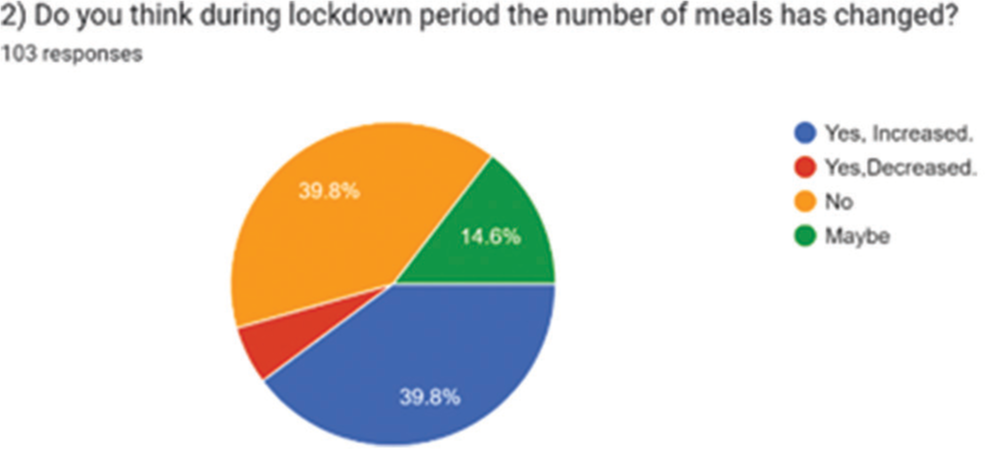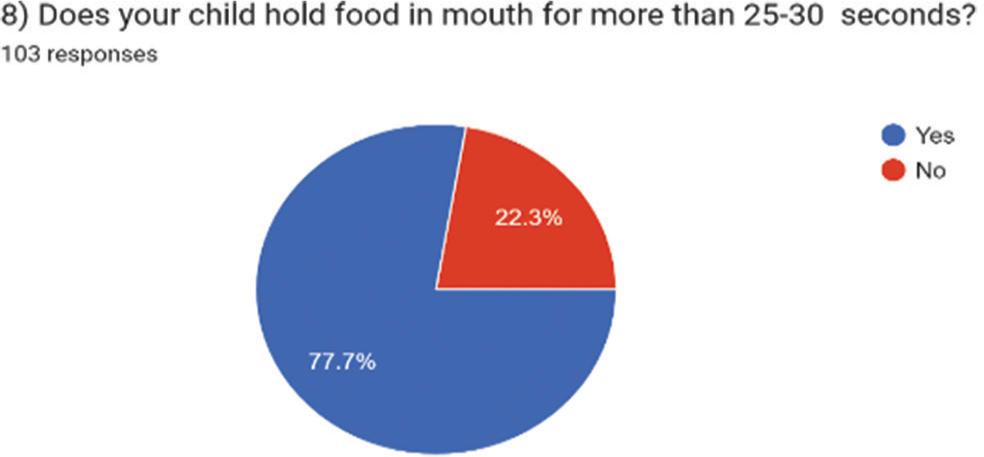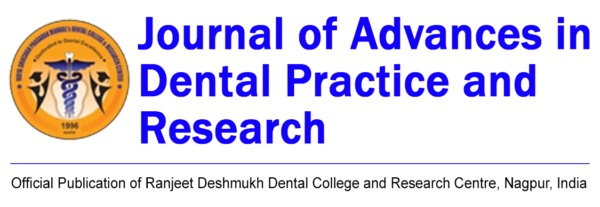Translate this page into:
Evaluation of the impact of lockdown during the COVID-19 outbreak on dietary habits in children between the age group 2 and 5 years in urban city of Maharashtra
*Corresponding author: Dr Purva Chaudhari, VSPM’s Dental College and Research Center, Nagpur, Maharashtra, India. purvachowdhari@gmail.com
-
Received: ,
Accepted: ,
How to cite this article: Gedam JS, Chaudhari P. Evaluation of the impact of lockdown during the COVID-19 outbreak on dietary habits in children between the age group 2 and 5 years in urban city of Maharashtra. J Adv Dental Pract Res 2023;2:11-4.
Abstract
Objectives:
The objective of the study was how COVID-19 impacted the dietary habits of children between the age 2 and 5 years. The aim of the study was to assess the dietary pattern of children of 2–5 years of age during the lockdown period. The objective is to evaluate the frequency of snacking, likes/ dislikes to various food items and the change in eating patterns during the lockdown period due to COVID-19.
Materials and Methods:
A cross-sectional and questionnaire-based survey was conducted among 100 school-going children in a corporation city of Maharashtra.
Results:
A total of 100 children between the ages of 2 and 5 participated in this survey. In addition, during the COVID lockdown period, the majority of children consume more meals and unhealthy fried snacks. In addition, children’s screen time has increased, which has increased their food holding time leading to carious teeth.
Conclusion:
During COVID lockdown period, children prefer unhealthy/fried food over fruits, vegetables, and other healthy options. They became more engrossed in the digital world while eating, affecting their mealtime due to the screen time. Parents are interested in providing their kids with dietary training to enhance their oral health.
Keywords
Dietary habits
COVID-19
Food pocketing
Holding food
INTRODUCTION
In March 2020, the World Health Organization declared the coronavirus outbreak as a global pandemic. The COVID-19 pandemic represents a massive impact on human health, causing sudden lifestyle changes, through social distancing and isolation at home, with social and economic consequences. Optimizing public health during this pandemic requires not only knowledge from the medical and biological sciences, but also of all human sciences related to lifestyle, social, and behavioral studies, including dietary habits and lifestyle.[1]
The effects of eating habits may last into adulthood and are vital for the physical and mental growth of children and adolescents. This systematic analysis sought to provide a complete and current account of how children’s and teenagers’ eating habits have changed as a result of being quarantined for COVID-19.[2]
Diet and nutrition of children influences not only their current health status but also have many long-term effects. A healthy dietary pattern in childhood will result in a lifetime of economic, social, and personal benefits. Appropriate feeding practices in childhood lead to a good nutritional status, improve physical and mental health, reduce susceptibility to infections, and stimulate psycho-sexual development.
Food holding is when children keep food it in their mouth without swallowing it. Most kids will hold it behind or in front of their gums or in their cheeks! In either case, it appears as though they are stuffing their food into a little pocket. A child may hold food in their mouth for a variety of reasons, including sensory issues, poor oral motor skills, and unpleasant swallowing. It could cause different oral health problems in children, such as cavities and other dental and health issues.
This study was done to assess the change in dietary preferences and patterns of children aged 2–5 years in the urban city in the lockdown period.
Aim
The aim of the study was to assess the dietary pattern of children of 2–5 years of age during lockdown period.
Objectives
The objectives of the study are as follows:
To evaluate the frequency of snacking, likes/dislikes to various food items lockdown period due to COVID-19.
To evaluate the change in eating patterns during the lockdown period due to COVID-19.
MATERIALS AND METHODS
A cross-sectional and questionnaire-based survey was conducted among 100 school-going children in a corporation city of Maharashtra.
The study participants were randomly selected parents/ guardians of children between the age group of 2–5 years from an urban city in Maharashtra.
The study was briefed and voluntary consent was obtained from each of the participants before conducting the study. The study was conducted on obtaining approval from the Institutional Ethical Committee.
School children visiting the outpatient department of the pediatric dentistry department aged 2–5 years were enrolled in the study. Children with other diseases like gastrointestinal diseases were excluded from the study.
RESULTS
A total of 100 participants participated in this survey. The participants are children in the age between 2 and 5 years. Results are captured as below in tables and graphs format.
In [Table 1], it is depicted how many meals children ate before to COVID. Out of 100 children, majority of them (58.3%) had three meals a day on average before COVID-19 breakout. [Table 2s] statistics indicate that most parents (41%) of children accepted the fact that their kids’ meal intake had changed during the lockdown. In terms of snacking, there has been an increase in the frequency of kids eating snacks before and during the lockdown. Furthermore, the study suggests that before COVID lockdown, majority of children (69.9%) used to consume 1 snack/per day which got doubled during lockdown period resulted. During the lockdown period, children tend to be more inclined toward fried snacks over other healthy options. Furthermore, highest number of children – 36.9% preferring fried food over other healthy food options. Furthermore, 86% of the parents agreed the fact that their child always watch digital screen (Mobile, laptop, and television) during meals which had affected the duration of their meal time.
| Number of meals | Number of children |
|---|---|
| >4 meals | 4 |
| 2 meals | 17 |
| 3 meals | 60 |
| 4 meals | 19 |
| Grand total | 100 |

| Response | Number of children |
|---|---|
| May be | 15 |
| No | 38 |
| Yes, increased | 41 |
| Yes, decreased | 6 |
| Grand total | 100 |

About 77% of the parents agreed that their child hold food in mouth for more than 25–30 s and out of them, 65% believe that it may be the reason for their children’s carious teeth. About 60% of children’s parents are willing to take dietary training to reduce the food holding time of children.
DISCUSSION
In this survey, 58.3% of youngsters reported eating three meals a day. The greatest reaction from parents was that their children’s quantity of meals had altered during the lockdown, with about 39.8% of parents/guardians making this claim. Before COVID lockdown, 69.9% of kids ate snacks once daily; following COVID lockdown that number dropped to 14.6%. The percentage of kids who ate snacks twice a day nearly doubled during the COVID lockdown period, rising from 20.4% to 42.7%. In addition, the number of kids who ate snack 3 times each day rose from 6.8% to 36.9%. The majority of kids favored fried snacks during the COVID lockdown. When asked if their child sees a digital screen during meals, 83.5% of parents and guardians responded “yes,” which was a significant value [Table 3]. Of them, 79.6% believed that it had a negative impact on the child’s mealtime [Table 4]. About 77.7% of parents and guardians said that their kids do indeed keep food in their mouths for longer than 25–30 s, and of those, 63.1% believe that this may be the cause of their kids’ carious teeth [Table 5]. By dietary training, 58.3% of parents and guardians wished to shorten their child’s meal holding time.
| Response | Number of children |
|---|---|
| No | 14 |
| Yes | 86 |
| Grand total | 100 |

| Response | Number of children |
|---|---|
| No | 21 |
| Yes | 79 |
| Grand total | 100 |

| Response | Number of children |
|---|---|
| No | 20 |
| Yes | 77 |
| Grand total | 97 |

In a study done in Rajasthan, India, it was found that this pandemic had affected people of all ages; however, children were most affected because of the increased exposure to junk food advertisements on television, and adolescents were most affected because this is the time when habits are formed, and any bad habits formed during this time will start to affect their adult lives.[3]
In a study carried out in Saudi Arabia, researchers predict that many children may consume higher-calorie diets during the pandemic response due to the COVID-19 lockdown. Furthermore, screen time is linked to childhood obesity, perhaps due to the dual problems of sedentary time and the link between screen time and snacking.[4]
According to a study done in Lebanon, youngsters who spend <2 h/day on screens are more likely to have clinical traits such as odd eating patterns. A total screen time, use of smartphone, sleep issues, owning electronic devices, and consumption of unhealthy foods in children.[5]
CONCLUSION
The data makes it quite evident that the COVID lockdown has had a significant influence on kids’ eating habits and behaviors. The number of meals the children consumed and the kind of food they preferred both before and during the lockdown have altered. According to our observation, kids tend to favor unhealthy/fried food over fruits, veggies, and other nutritious choices. Due to the absence of outside activities brought on by COVID rules, children became more immersed in the digital world when eating, which affected their lunchtime. This study reported that many parents are interested in teaching their children healthy eating habits to improve their dental health.
Limitations
Because the study was questionnaire-based, the patient responses might be skewed. In addition, because the study was carried out during a brief period of time, the sample size was smaller. The results cannot be applied to the society as the study population was restricted to a small number of individuals from Nagpur city. The study will need to be prolonged by include additional cities and for a longer period of time to produce more exact results that can be used generally.
Acknowledgment
The authors would like to express their gratitude to all the participating parents for their cooperation and participation in the study as well as to the renowned Dean of VSPM DC and RC, Nagpur, for giving us the chance to conduct this study.
Declaration of patient consent
Patient’s consent not required as there are no patients in this study.
Conflicts of interest
There are no conflicts of interest.
Financial support and sponsorship
Nil.
References
- Eating habits and lifestyle changes during COVID-19 lockdown: An Italian survey. J Transl Med. 2020;18:229.
- [CrossRef] [PubMed] [Google Scholar]
- Eating habits of children and adolescents during the COVID-19 era: A systematic review. Front Nutr. 2022;9:1004953.
- [CrossRef] [PubMed] [Google Scholar]
- Impact of Covid-19 on alterations in food habits and lifestyle behaviour of Indians: A review. Acta Sci Nutr Health. 2021;5:96-103.
- [CrossRef] [Google Scholar]
- Young children's nutrition during the COVID-19 pandemic Lockdown: A comparative study. Early Child Educ J. 2021;49:915-23.
- [CrossRef] [PubMed] [Google Scholar]
- Effect of screen time on physical and mental health and eating habits. During COVID-19 Lockdown in Lebanon. Psychiatry Investig. 2022;19:220-8.
- [CrossRef] [PubMed] [Google Scholar]






